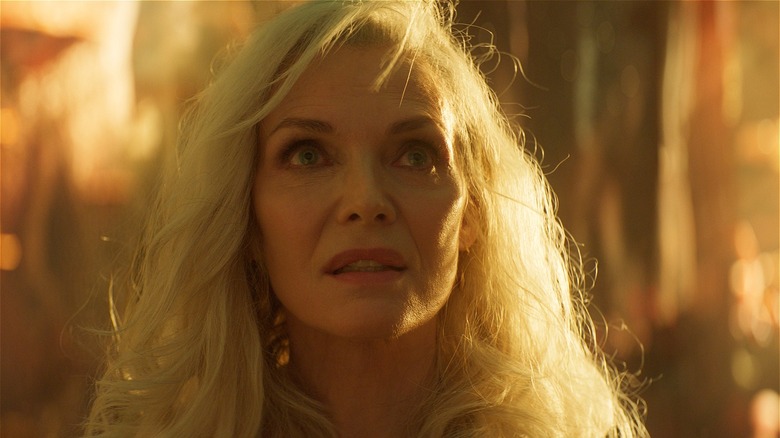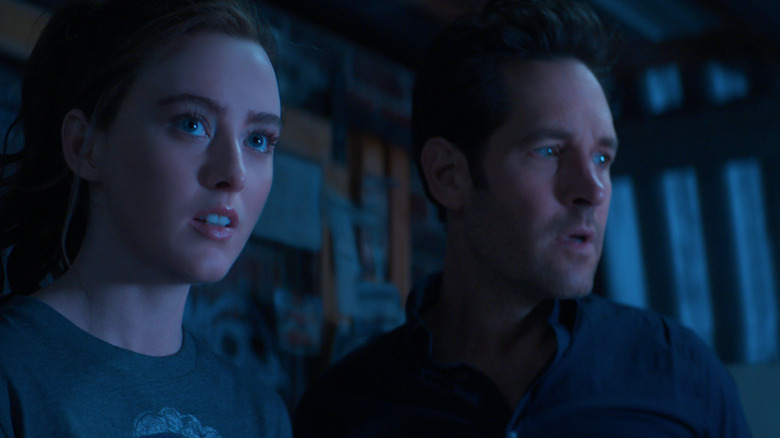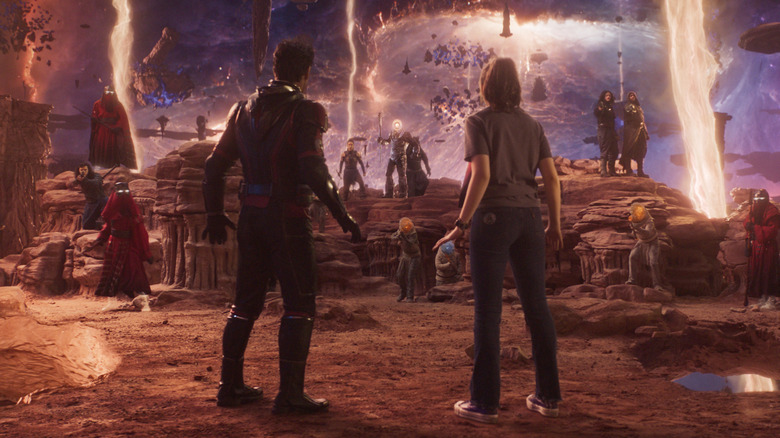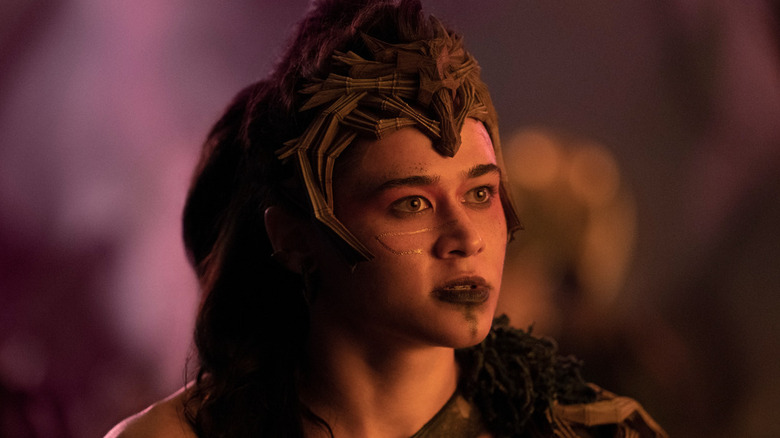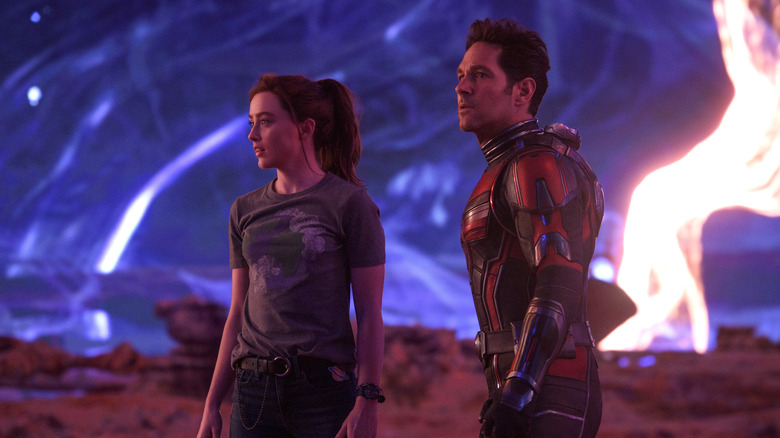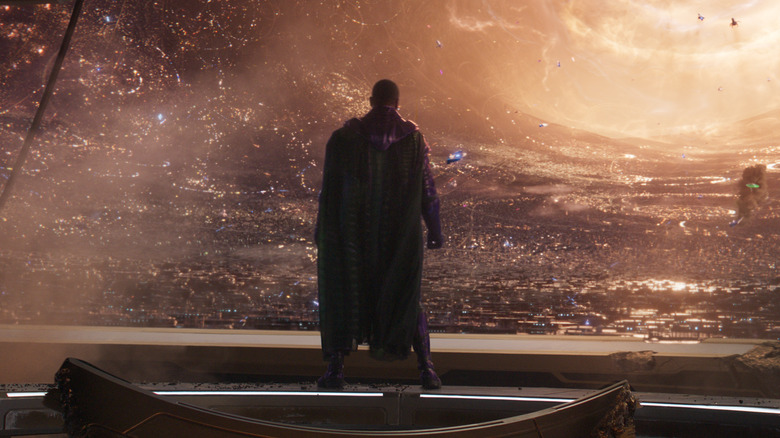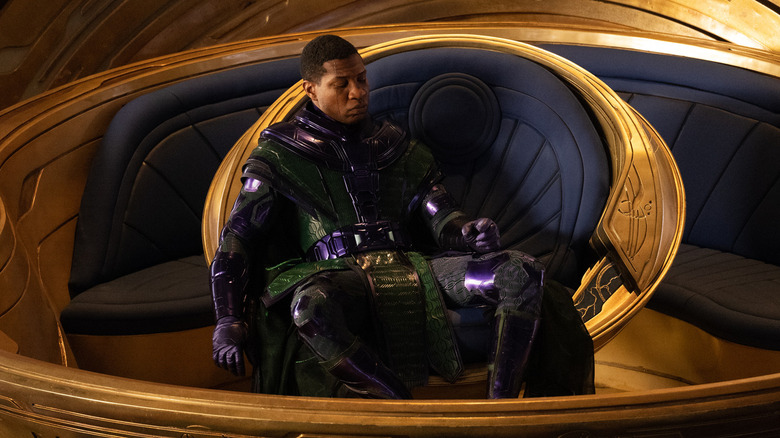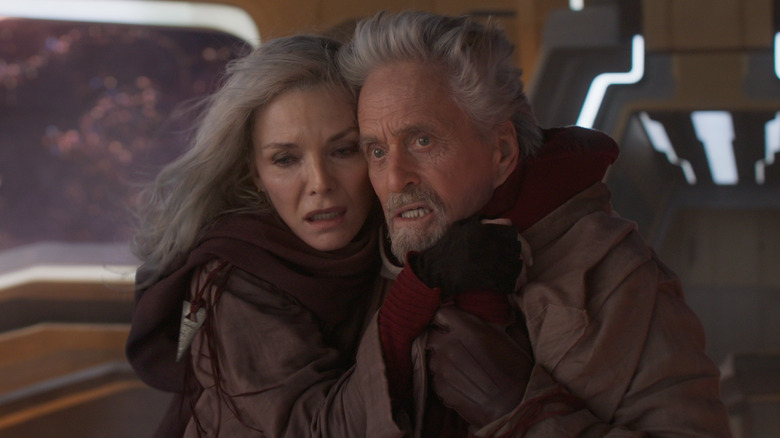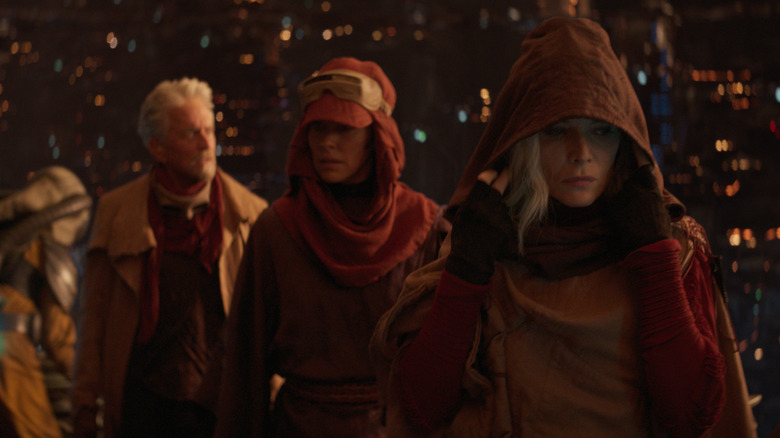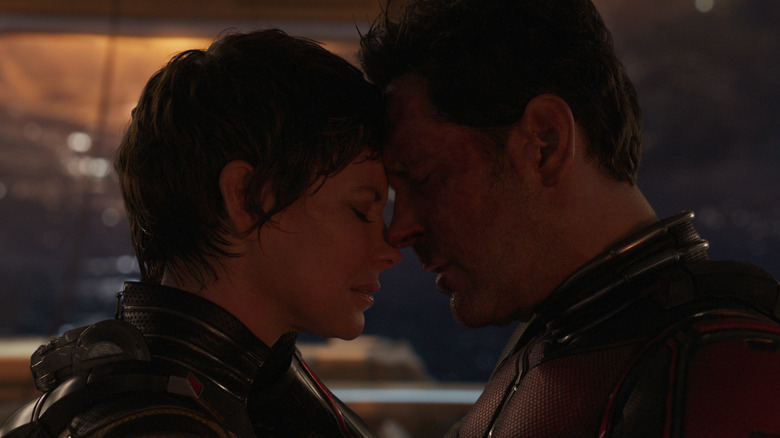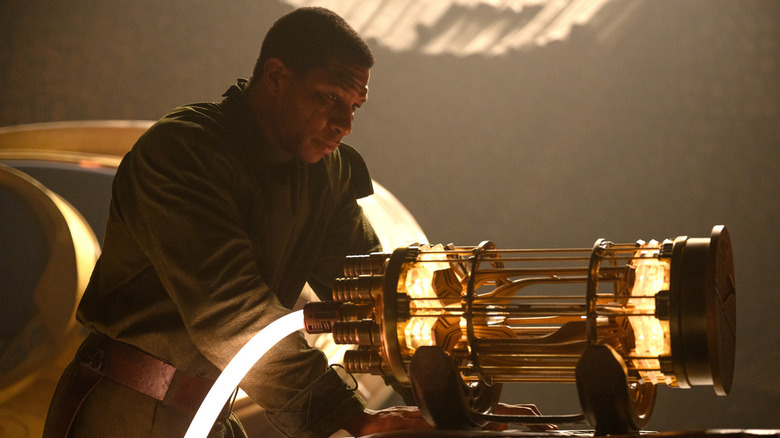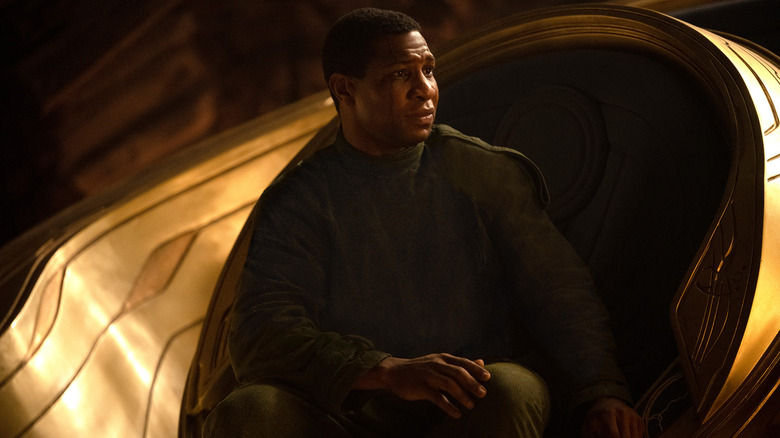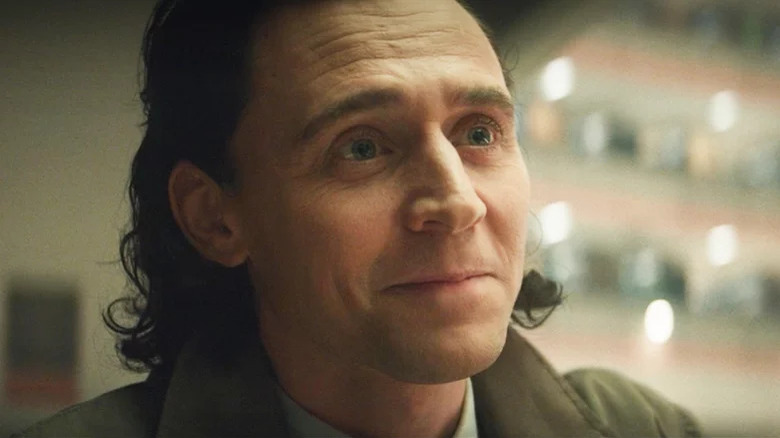Biggest Unanswered Questions In Ant-Man And The Wasp: Quantumania
"Ant-Man and the Wasp: Quantumania" kicks off the MCU's Phase 5 with a chaotic bang, delivering a colorful exploration of the mysterious Quantum Realm. The film largely serves as an official introduction for Kang the Conqueror (Jonathan Majors), the villain who'll be tormenting Earth's mightiest heroes on the big screen for years to come. However, it's also a fantastical odyssey in its own right.
After being sucked back into the subatomic Quantum Realm by a mysterious force, Scott and Cassie Lang (Paul Rudd and Kathryn Newton), Hope and Janet van Dyne (Evangeline Lilly and Michelle Pfeiffer), and Hank Pym (Michael Douglas) are pitted against Kang himself. They join forces with a resistance movement led by the brave warrior Jentorra (Katy O'Brian) and the telepathic Quaz (William Jackson Harper). As the story unfolds, Janet reveals her complicated history with Kang, which began after he was banished to the Quantum Realm by his numerous other variants.
"Quantumania" does a lot to set up Phase 5 and beyond, establishing the Kang threat and introducing a number of new characters. However, it's also downright psychedelic at times. If the film's more bizarre moments left you a little confused, fear not: We're going through the biggest unanswered questions in "Quantumania" and their most likely answers.
Warning: spoilers ahead for "Ant-Man and the Wasp: Quantumania."
How does Cassie's machine work?
The whole plot of "Quantumania" kicks off because Cassie Lang is secretly a brilliant young scientist. With some help from Hope and Hank, she designs a device that can peer down into the Quantum Realm and map it. She tells her dad that the invention is based on Hank's journals, which she read thoroughly in the years following Thanos' snap. Cassie describes the device as being like a satellite, while Hank compares it to the Hubble Telescope, only for subatomic universes. Whatever the exact details, it's clearly meant to be a window, not a gate. However, its signal is strong enough for Kang to lock onto it from the Quantum Realm in only a matter of seconds and pull the entire family down to his level.
Debating the semantics of impossible sci-fi tech isn't necessary a worthwhile endeavor, but there's a lot about Cassie's device that could use some additional explanation. Kang is clearly unable to leave the Quantum Realm without fully reactivating his multiverse drive — Janet says as much later in the film. The reason it works as a prison for him is that it exists outside of both time and space, according to her. He is able to bring people down to him, though, which doesn't seem all that different from getting out. Is it Cassie's device that makes this possible? Perhaps, but with all of Kang's advanced technology, you'd think he'd be able to make something similar. The confusion is only magnified during the film's climax, but more on that later.
How does the Quantum Realm actually work?
Perhaps the most perplexing part of "Ant-Man and the Wasp: Quantumania" is that the film doesn't really explain how the Quantum Realm actually works. That's partially because its weird temporal properties make it impossible for us mere humans to understand, but the film rarely even tries to address the rules of the world in a consistent way.
For instance, when the Lang gang is pulled into the tiny dimension by Kang, Hank's technologically savvy ants are taken with them. They return in the film's final act as an advanced super-species and aid Hank and his family. The explanation for this bizarre deus-ex-ant? On their way down, the ants hit a "temporal anomaly" and lived for a thousand years ... somewhere (when?) else.
While this is totally feasible within our understanding of the Quantum Realm, it seems odd that it only happens to the ants. The five main characters all land in the same temporal moment and in relatively close proximity. Krylar has aged the same amount as Janet has since her departure, and when the crew escapes at the end, no significant time has passed. Again, this all technically makes sense, but it also positions the Quantum Realm as more of a convenient plot device than a fascinating alternate dimension. Why does it only do weird time stuff when it's convenient for the story? A consistent set of rules would help this feel less contrived, but "Quantumania" seems uninterested in providing that.
Why do people in the Quantum Realm look human?
When Scott and company arrive in the Quantum Realm, they find a land that could fit into nearly any sci-fi or fantasy universe. There are various alien species, weird technologies, and bizarre flora and fauna — just on a subatomic scale. But since everything in the Quantum Realm is tiny, none of it feels particular unique. Overall, it comes across more like a far-away planet than it does the MCU's other mystical realms — the Astral Dimension, the Dark Dimension, etc. Heck, it even has beer.
Given how relatively comparable the Quantum Realm (or at least the city of Axia) is to the rest of the MCU, it might not seem that surprising to see humans walking around. But it should be. Much of the sentient life in and around Axia is otherworldly, but there are plenty of people who just look like, well, people. Hank brings this up at one point to Krylar (Bill Murray), who gives a gross non-answer. After that, it's never brought up again.
Perhaps the humanoid denizens of the Quantum Realm are descendants of future humans, who entered the strange dimension and wound up trapped. Or maybe Marvel Studios just decided to skimp on the prosthetics department and drop in straight-up humans because it's easier.
Why does Cassie wait so long to use her suit?
If you're a fan of the comics, you probably weren't too surprised by Cassie Lang's superhero transformation in "Quantumania." She's fought against numerous threats on the illustrated page, operating under the monikers "Stinger" and "Stature" (among others), and even joining the Young Avengers at one point. She seems well on her way down the same path in the MCU, with "Quantumania" revealing her own unique Ant-Man suit and some impressive combat skills.
As exciting as it is when Cassie finally puts the suit on, it seems a little weird that she holds off for as long as she does. She mentions having a suit very early on, but she doesn't don it until Jentorra's camp is being attacked almost halfway through the movie. Why didn't she put it on during her fall into the Quantum Realm like Scott and Hope do? Why not put it on when her dad is being attacked by a giant alien squid? Surely she's not worried about getting grounded in these moments, so why not give herself the best chance of survival and put the dang suit on?
The most compelling in-universe explanation is that Cassie is just overwhelmed. It's not hard to imagine the stress and shock of the whole ordeal causing some mental lapses. The other, less satisfying answer is that the script simply holds the suit reveal for dramatic reasons, even though we all know it's coming.
What's Krylar's deal?
In a movie filled with broccoli-headed aliens and sentient ooze, the seemingly ordinary Krylar still manages to be one of the most perplexing characters. His mere inclusion in "Quantumania" feels like little more than a wink-and-nod to the audience, saying, "Look, it's Bill Murray! Remember Bill Murray?" These days, audiences would likely respond with, "Yes, he's the guy with all kinds of misconduct allegations against him going back decades." It's a baffling time to write a character who's so transparently just a vehicle for the actor. Krylar features in only one scene, and yet he gets almost as many lines as Jentorra.
Aside from the highly questionable decision of including Murray in the first place (especially given his character's unimportance to the story), Krylar just doesn't add up. He was apparently one of Janet's main allies in her freedom-fighting campaign against Kang, and even her lover. But now he's a "lord" — a title that, like pretty much all of the movie's Quantum Realm world-building, is given zero meaning. Why is he so important in Kang's regime now after battling him for so long? Why wouldn't Kang have just killed him and installed a less troublesome figurehead in his place?
The character makes no sense, and he clearly wasn't meant to. His only purpose is to shoehorn in a cameo from an actor who, these days, comes with a ton of baggage.
Why was Kang the Conqueror exiled?
After dodging clarifying questions from her family for roughly half the movie, Janet van Dyne finally explains her history with Kang. We learn from her that he was cast out of the multiverse by the other Kang variants and exiled specifically to the Quantum Realm. Since the strange dimension exists outside of both regular space and the timestream, he has no easy way out.
Later, Kang provides some illumination on why he was banished in the first place. He claims to have seen the end of time and how his variants destroy the multiverse — something hinted at by another Kang variant, He Who Remains, in "Loki" Season 1. But when Janet gains access to his mind through his ship's neural link, she sees that he might be the worst of them all. She says that this Kang has wiped out entire timelines — the same thing he's accusing his brethren of doing.
So what actually happened between this particular Kang and the others? None of them seem particularly affronted by the concept of wanton destruction and warmongering. Did the exile simply tread on the others' toes too much? Assert himself as better than them? That seems like the most likely explanation. It's hard to imagine his pursuits actually being noble, and everything he says should be taken with a grain of salt.
What is Janet still hiding?
Much of the responsibility for what happens in "Ant-Man and the Wasp: Quantumania" can be left squarely at Janet van Dyne's feet. It makes sense that she'd hold off on talking about her time in the Quantum Realm for a while, as the ordeal was quite traumatic. And as we learn, she also carries a great deal of guilt for her role in helping Kang conquer Axia. "I unleashed a monster on this place and ran away," she says at one point. It's not exactly the kind of thing you want to tell your kid about.
Unfortunately, "Quantumania" has Janet withhold so much information so many times that it becomes tiresome. There are plenty of opportunities for her to explain the Kang situation to Hope and Hank before she does, but she just keeps repeating that there isn't enough time. She also could have done the whole family a favor by politely asking to avoid further contact with the Quantum Realm. Sure, that might have led to some questions she'd rather not answer, but wouldn't her fear of Kang make her take some precautions?
Given all this, it seems unlikely that Janet has divulged everything that's important by the end of the movie. The Quantum Realm is a strange place, and she was there for a very long time. It's likely that Kang isn't the only dangerous person she encountered. Additionally, she saw into his brain. There's got to be more that she gleaned from that experience than she admits in "Quantumania."
What does the rest of the Quantum Realm look like?
Although the Quantum Realm is described as being almost infinitely big (or small, depending on how you look at it), "Quantumania" only takes place in a small corner of it. The city of Axia and the surrounding area is where Kang has built his empire, and conveniently, it's also where all five of our protagonists land. This is a very different portrait of the Quantum Realm from what's shown in earlier MCU movies, and it begs the question, does it all look like this?
The short answer is no. By its very nature, the Quantum Realm is fantastical, ever-changing, and impossible to fully comprehend. But "Quantumania" doesn't do a very good job of showing us that diverse landscape — especially for a movie in which the Quantum Realm is supposedly the star. The bits we do visit are pretty similar, and the ways in which they're different are the same as in our world. There are deserts, and there are forests. There are citadels, and there are bars.
With Kang only becoming more central to the MCU as time goes on, we could return to the Quantum Realm in future projects. It would be fun to explore a wider swath of this dimension than what's seen in the "Ant-Man" films.
How do Scott and Hope get home?
At the end of "Ant-Man and the Wasp: Quantumania," Scott and Hope have a climactic battle against Kang in his throne room. They're able to get Hank, Janet, and Cassie home through a portal created by Kang's multiverse drive, but in defeating him, they have to overload the drive, thus closing their way back. For a moment, it looks like they might be trapped in the Quantum Realm forever. But only for a moment.
Using the device she shows off at the beginning of the film, Cassie quickly reopens the portal, allowing Hope and Scott to escape. It's nice to see the whole family back together and safe, but this scene is incredibly confusing given what's shown in the rest of the movie. Kang and Janet say multiple times that the only way for him to escape is by repairing the core of his multiverse drive. So how is Cassie still able to open a gateway after the drive has seemingly been destroyed?
If her device alone were able to create a portal, why couldn't Kang have just built the same thing? If the multiverse drive isn't actually destroyed, then why does it appear to vaporize Kang and overload? Even after the second portal opens, Scott and Hope completely undersell it, as if they knew they still had a way home. This doesn't quite make sense and honestly feels like a major plot hole.
What happens to Kang?
In his final showdown with Kang, Scott overloads the multiverse drive core using a handful of Pym Particle disks. Kang desperately tries to stop the device from going ballistic, but it's too late. What happens next, though, is a lot more bewildering. Kang appears to be vaporized out of existence by the drive. Later, in the film's mid-credits scene, the Council of Kangs claims that he's dead. But is this true?
It's unclear what exactly Scott does to the multiverse drive, and it's equally unclear what it does to Kang. Since the device is capable of jumping across realities, it's conceivable that Kang was simply transported somewhere else. Sure, the Council of Kangs seems powerful, but there must be a way for him to cover his tracks in the grand landscape of the multiverse, right?
Given how much time is spent developing this Kang variant in particular, it seems too soon to write him off as dead. The MCU is already using numerous Kang variants as villains in different stories, but it's much easier for audiences to care about a single bad guy. "Quantumania" clearly wants us to care about this specific Kang, so it would be kind of a waste if he's truly gone forever.
What does the Council of Kangs want?
Midway through the credits for "Ant-Man and the Wasp: Quantumania" is a brief glimpse at what the other Kangs of the multiverse are up to. The scene follows three main variants — an imperial-looking Kang who seems to lead the meeting and resembles the comic book character Immortus, another dressed as a Pharaoh who may be Rama-Tut (Kang's first iteration in the comics), and a third who looks robotic, as is from a distant future. This final Kang could be compared to Kid Immortus, another of his versions from the comics, but he could also be something else entirely.
The Kang who looks like Immortus says that the exiled variant is dead, but that he is concerned about an unspecified "them." Presumably, this is a reference to Scott and the crew, and likely the main-timeline Avengers at large. To address this perceived threat, the lead variant has called all the other Kangs in the multiverse together. They seem to be preparing for war, but their exact plans are left unclear.
There are ton of questions here, from who these variants really are to what they'll do next. Both the exiled Kang and He Who Remains from "Loki" Season 1 have claimed that the Kang collective will bring about the end of all things. However, it's a little hard to take them seriously as presented in the credits of "Quantumania." Season 2 of "Loki," "Avengers: The Kang Dynasty," and even the MCU's upcoming "Fantastic Four" movie may all provide some clarity.
What are Loki and Mobius up to?
After the Council of Kangs scene, "Quantumania" has one more surprise — a post-credits tease for "Loki" Season 2. The brief clip shows Loki (Tom Hiddleston) and Mobius (Owen Wilson), his ally/partner/captor in the Time Variance Authority (TVA), attending an exposition of some kind in what looks like the 19th century. A Kang variant named Victor Timely appears onstage to philosophize about time, but we don't see enough of the show to know what he's actually up to. Could this be the same Kang Ant-Man just defeated? Or one who hasn't yet accessed the multiverse? One thing that's clear is that Loki is quite unnerved to see him.
Even more intriguing is how and why Loki and Mobius are there, especially together. After learning about Kang at the end of "Loki" Season 1, the God of Mischief seemed bent on stopping his (their?) rise. But when he returns to the TVA at the end of that season, his whole timeline has been rewritten, and Mobius doesn't even know who he is.
Since it would be weird to skip the process of Loki and Mobius rebuilding their relationship, this scene likely takes place at least midway through "Loki" Season 2. But of course, with time itself now a malleable mess in the MCU, anything is possible. It remains to be seen exactly what Loki and Mobius' rapport is at this point, and what they're doing with this particular Kang.
